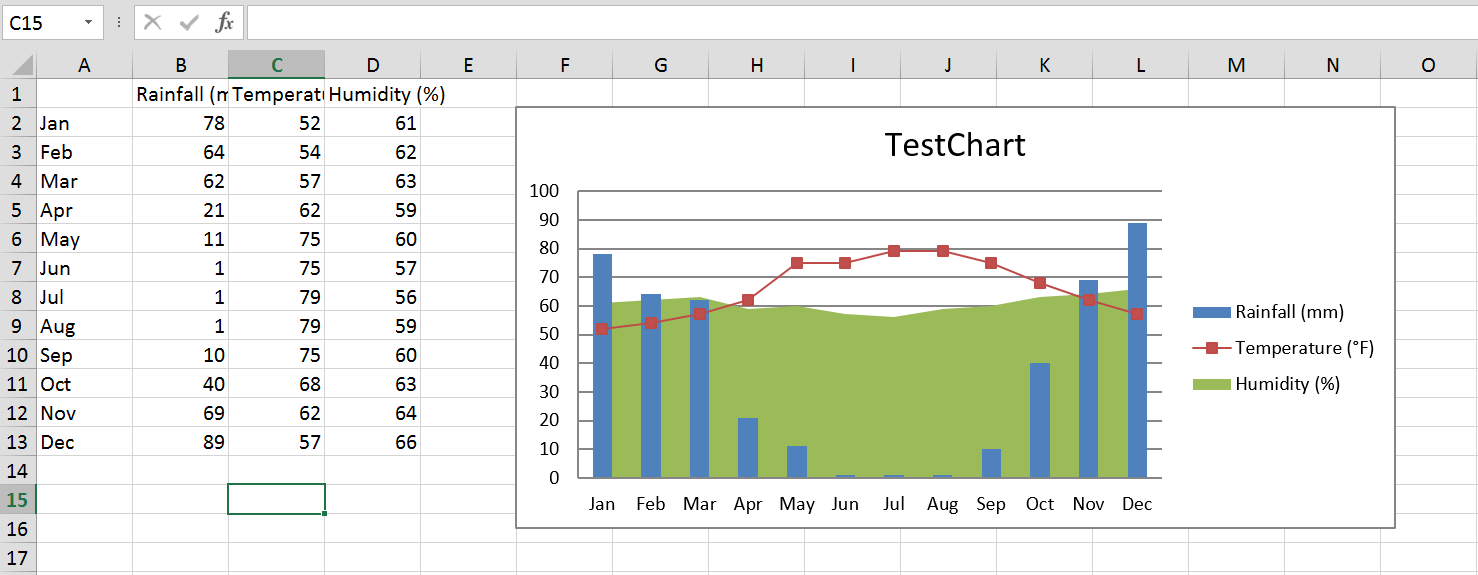使用Microsoft Excel打开时, PHPExcel生成的excel文件不起作用(文件格式或扩展名无效)吗?如果你是这个可怕问题的受害者, 则可能有很多因素导致此消息。
如果你使用的是纯PHP, 则使用以下代码:
$excelWriter->save("php://output");
Mark Baker(PHPOffice开发人员)说:
检查你的脚本, 以查看将其发送到php:// output流的位置。检查初始<?php开头标记之前是否没有空格;特别要注意?> <?php或类似的关闭/打开标签。并检查脚本可能包含的所有文件。在这里阅读更多
这是很难实现的, 因为很难检查标记之间的文件之间是否有空格(如果你使用的是symfony之类的框架, 这将是一项艰巨的任务), 但是有些开发人员使用:
ob_end_clean(); // ob_end_clean Cleans the output buffer and turn off output buffering
$excelWriter->save("php://output");如果先前的解决方案对你不起作用, 那么你只剩下一个选择, 但是在继续之前, 你应该了解一些重要的注意事项:
- 流式响应几乎总是会生成损坏的文件。
- PHPExcel可能不是损坏文件的唯一罪魁祸首, 在大多数情况下, 你的代码(绘制数据的方式)可能已损坏。
- 使用save方法将文件保存在服务器中的某个位置, 然后根据需要生成文件下载(直接或间接)。
以下代码将使用基本图表示例创建一个不会损坏的excel文件, 请对其进行测试:
// Remove the \ before every class if you're using plain php ( new \PHP_Something)
public function createexcelfileAction() {
// if you are using plain php use instead, //$excel = new PHPExcel();
$excel = $this->get('phpexcel')->createPHPExcelObject();
$excel->createSheet();
$excel->setActiveSheetIndex(1);
$excel->getActiveSheet()->setTitle('ChartTest');
$objWorksheet = $excel->getActiveSheet();
$objWorksheet->fromArray(
array(
array('', 'Rainfall (mm)', 'Temperature (°F)', 'Humidity (%)'), array('Jan', 78, 52, 61), array('Feb', 64, 54, 62), array('Mar', 62, 57, 63), array('Apr', 21, 62, 59), array('May', 11, 75, 60), array('Jun', 1, 75, 57), array('Jul', 1, 79, 56), array('Aug', 1, 79, 59), array('Sep', 10, 75, 60), array('Oct', 40, 68, 63), array('Nov', 69, 62, 64), array('Dec', 89, 57, 66), )
);
// Set the Labels for each data series we want to plot
// Datatype
// Cell reference for data
// Format Code
// Number of datapoints in series
// Data values
// Data Marker
$dataseriesLabels1 = array(
new \PHPExcel_Chart_DataSeriesValues('String', 'Grafico!$B$1', NULL, 1), // Temperature
);
$dataseriesLabels2 = array(
new \PHPExcel_Chart_DataSeriesValues('String', 'Grafico!$C$1', NULL, 1), // Rainfall
);
$dataseriesLabels3 = array(
new \PHPExcel_Chart_DataSeriesValues('String', 'Grafico!$D$1', NULL, 1), // Humidity
);
// Set the X-Axis Labels
// Datatype
// Cell reference for data
// Format Code
// Number of datapoints in series
// Data values
// Data Marker
$xAxisTickValues = array(
new \PHPExcel_Chart_DataSeriesValues('String', 'Grafico!$A$2:$A$13', NULL, 12), // Jan to Dec
);
// Set the Data values for each data series we want to plot
// Datatype
// Cell reference for data
// Format Code
// Number of datapoints in series
// Data values
// Data Marker
$dataSeriesValues1 = array(
new \PHPExcel_Chart_DataSeriesValues('Number', 'Grafico!$B$2:$B$13', NULL, 12), );
// Build the dataseries
$series1 = new \PHPExcel_Chart_DataSeries(
\PHPExcel_Chart_DataSeries::TYPE_BARCHART, // plotType
\PHPExcel_Chart_DataSeries::GROUPING_CLUSTERED, // plotGrouping
range(0, count($dataSeriesValues1) - 1), // plotOrder
$dataseriesLabels1, // plotLabel
$xAxisTickValues, // plotCategory
$dataSeriesValues1 // plotValues
);
// Set additional dataseries parameters
// Make it a vertical column rather than a horizontal bar graph
$series1->setPlotDirection(\PHPExcel_Chart_DataSeries::DIRECTION_COL);
// Set the Data values for each data series we want to plot
// Datatype
// Cell reference for data
// Format Code
// Number of datapoints in series
// Data values
// Data Marker
$dataSeriesValues2 = array(
new \PHPExcel_Chart_DataSeriesValues('Number', 'Grafico!$C$2:$C$13', NULL, 12), );
// Build the dataseries
$series2 = new \PHPExcel_Chart_DataSeries(
\PHPExcel_Chart_DataSeries::TYPE_LINECHART, // plotType
\PHPExcel_Chart_DataSeries::GROUPING_STANDARD, // plotGrouping
range(0, count($dataSeriesValues2) - 1), // plotOrder
$dataseriesLabels2, // plotLabel
NULL, // plotCategory
$dataSeriesValues2 // plotValues
);
// Set the Data values for each data series we want to plot
// Datatype
// Cell reference for data
// Format Code
// Number of datapoints in series
// Data values
// Data Marker
$dataSeriesValues3 = array(
new \PHPExcel_Chart_DataSeriesValues('Number', 'Grafico!$D$2:$D$13', NULL, 12), );
// Build the dataseries
$series3 = new \PHPExcel_Chart_DataSeries(
\PHPExcel_Chart_DataSeries::TYPE_AREACHART, // plotType
\PHPExcel_Chart_DataSeries::GROUPING_STANDARD, // plotGrouping
range(0, count($dataSeriesValues2) - 1), // plotOrder
$dataseriesLabels3, // plotLabel
NULL, // plotCategory
$dataSeriesValues3 // plotValues
);
// Set the series in the plot area
$plotarea = new \PHPExcel_Chart_PlotArea(NULL, array($series1, $series2, $series3));
// Set the chart legend
$legend = new \PHPExcel_Chart_Legend(\PHPExcel_Chart_Legend::POSITION_RIGHT, NULL, false);
$title = new \PHPExcel_Chart_Title('Chart awesome');
// Create the chart
$chart = new \PHPExcel_Chart(
'chart1', // name
$title, // title
$legend, // legend
$plotarea, // plotArea
true, // plotVisibleOnly
0, // displayBlanksAs
NULL, // xAxisLabel
NULL // yAxisLabel
);
// Set the position where the chart should appear in the worksheet
$chart->setTopLeftPosition('F2');
$chart->setBottomRightPosition('O16');
// Add the chart to the worksheet
$objWorksheet->addChart($chart);
// if you're using plain php use instead :
// $writer = new PHPExcel_Writer_Excel2007($excel);
$writer = $this->get('phpexcel')->createWriter($excel, 'Excel2007');
$writer->setIncludeCharts(TRUE);
// Save the file somewhere in your project
$writer->save('file.xlsx');
// then your file will be not corrupted anymore
// Do not use streamed responses with excel files that include charts ! otherwise it will get corrupted
/**
$response = $this->get('phpexcel')->createStreamedResponse($writer);
// adding headers
$dispositionHeader = $response->headers->makeDisposition(
ResponseHeaderBag::DISPOSITION_ATTACHMENT, 'stream-file.xlsx'
);
$response->headers->set('Content-Type', 'text/vnd.ms-excel; charset=utf-8');
$response->headers->set('Pragma', 'public');
$response->headers->set('Cache-Control', 'maxage=1');
$response->headers->set('Content-Disposition', $dispositionHeader);
**/
// YOU NEED TO GIVE YOUR OWN RESPONSE, OTHERWISE THIS WILL THROW ERROR
return 'Create your own response';
}如果一切正常, 则生成的excel文件将是具有以下内容的普通excel文件(并且没有损坏的文件消息):

现在一切都应该井井有条, 但是你需要测试使用save方法(而不是流式响应)保存文件的代码。
如果文件仍然损坏, 则绝对应该重新评估代码, 并检查是否使用感知数据进行渲染, 因为这可能是问题所在。
如果你在此处访问官方的phpexcel github存储库, 则可以获取更多图表示例, 其中有许多示例说明了如何使用不同类型的图表。愿原力与你同在 !
 srcmini
srcmini
评论前必须登录!
注册